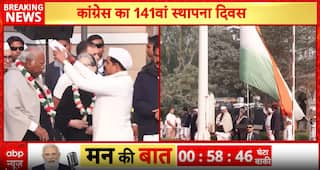Explorer
Modi 2.0 Anniversary: Big Reforms, Little Impact As Economic Challenges Grow Manifold
There are several economic reforms unleashed by Modi 2.0 in the wake of Covid-19 outbreak which has battered the economy. However, challenges have grown manifold since then as the BJP-led government moves on to third term.

India Prime Minister Narendra Modi (R) gestures to supporters next to Bharatiya Janta Party (BJP) president Amit Shah wave as they celebrate the victory in India's general election at the party headquarters in New Delhi on May 23, 2019. FILE PIC/AFP,
New Delhi: Prime Minister Narendra Modi took over the second tenure with a clear vision of making India a $5 trillion economy by 2024. In the last one year, there were a slew of measures taken to push the agendas from doubling the farmer’s income by 2022, privatisation, labour reforms to mergers of public sector banks. With the outbreak of Covid-19, the economy has become one of the biggest battlefields for Modi Sarkar 2.0 even as the growth remained sluggish since last year. One of the highlights of the election manifesto was making the country a $5 trillion economy by 2025 and a $10 trillion economy by 2032. The revenue has been badly affected due to Covid-19 induced lockdown and these goals look much difficult to attain in the coming months. Here is what the BJP-led manifesto promised along with the overhaul of the economy. Labour reforms paving the way for ease of business The Industrial Relations (IR) Code Bill, 2019, which was approved by the Cabinet last year, will offer a major push to the ease of business. The bill basically merges the Trade Unions Act, 1926; the Industrial Employment Act, 1946; and the Industrial Disputes Act, 1947. It provides a legal framework for fixed-term employment enabling companies to hire more employees on contract, offer flexibility in hiring and firing of employees, and closure of units. The code has retained the employee threshold at 100 for firing employees or closing an industrial unit without prior approval. It, however, has a provision to change this threshold through executive orders without amending the Act. But it could be resisted by unions leading to industrial unrest as the proposed law restrains worker’s power of collective bargaining, job safety and right to resent. Modi 2.0 Anniversary: From MH-60 Romeo Helicopters To R-27 Missiles, Major Defence Deals Inked By NDA Govt In Last 1 Year Tax cuts to boost manufacturing The government has slashed corporate tax to 25.17 per cent, inclusive of all cess and surcharges, for domestic companies while 15 per cent for new domestic manufacturing companies. All those new domestic manufacturing companies formed after October 1, can pay income tax at a rate of 15 per cent without any incentives. It means that effective tax rate for new manufacturing companies will be around 17.01 per cent including surcharge and cess. This was aimed to spur the economic growth which has been sagging after five continuous quarters witnessed sluggishness with India losing its status to China as the fastest-growing economy. In 2019, two budgets-interim and one full were announced by finance minister Nirmala Sitharaman to fix the economy. The first announcement raised the surcharge on Income Tax for both domestic and foreign portfolio investors but a month later it was rolled back. However, it couldn’t really press the rest button to economy. This year it had introduced six slabs within an annual income of Rs 15 lakh. There is very little relief for the middle and salaried class, who had already faced troubles with the implementation of demonetisation and Goods and Services Tax impacting spending and consumption. Even crude prices crashed to a historic low but the government didn’t pass on the benefit to consumers, but duties on diesel by Rs 13 a litre and on petrol by Rs 10 litre. Focus on agriculture For farmers, the scheme Pradhan Mantri Kisan Samman Nidhi (PM-Kisan) has been extended to all farmers. This was the manifesto promise of the BJP. PM Kisan was extended to all farmers, taking total beneficiaries to 14.5 crore and farmers received direct income support of ₹6,000 per year, according to PM. One of the key focuses of the government was to doubling farmers' income. There were several measures from draft seeds bull, income transfer scheme, minimum support price and farmer producer organisations (FPOs) and zero budget natural farming. Despite several measures, experts are wary about the prospects and think it's difficult to double farm incomes by 2022 because of the poor agriculture growth rate in the recent past. The disinvestment dream The privatization of Air India was a touted project which the government had promised as the airline had accumulated losses of more than Rs 60,000 crore. Other than this disinvestment from the Life Insurance Corporation was also under focus. But there has been no update on both fronts. The government also brought focus on new public sector policy “where all sectors are open to the private sector, while public sector enterprises (PSEs) play an important role in defined areas”. It means in other sectors, PSEs will be privatized while the number of enterprises in strategic sectors will remain one to four. PSU banks mergers The government had announced mega bank mergers to revamp the banking sector by infusing ₹70,000 crore in the banks for 2019-2020. One of the biggest decisions of the government remains the mergers of 10 public sector banks into four big banks. This led to the consolidation making the banks stronger and competitive. This led to optimisation of manpower besides addressing overlap of branches across India thus reducing the costs of running them. There are several other reforms unleashed by Modi 2.0 in the wake of Covid-19 outbreak which has battered the economy. However, challenges have grown manifold as the BJP-led government moves on to the third term. Also Watch: Modi govt 2.0 anniversary: Take a look at mega celebrations' plans
Related Video
Union Budget 2025: Arvind Kejriwal lists the shortcomings of the Modi government's budget | ABP News | AAP
Follow Business News on ABP Live for more latest stories and trending topics. Watch breaking news and top headlines online on ABP News LIVE TV





































